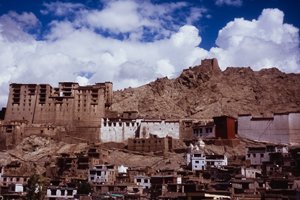
Ladakh, The Land of high passes in Himalayan region in the Indian state of Jammu and Kashmir that currently extended from Kunlun Mountain Range to the Great Himalaya Range to the south and inhabited people are Indo-Aryan and Tibetan descent. Ladakh region historically includes the Baltistan, entire upper Indus valley, Zanskar valley, Nubra valley, Lahaul and Spiti valley to the south, Ngri, Rudok and Guge in the east.
Ladakh places to visit in Leh Ladakh, The best places to visit in Leh Ladakh and places to see in Ladakh tourist attraction are Pangong Lake, Khardongla-pass, Nubra valley, Tsomoriri Lake, thikse monastery, Leh palace, Shanti Stupa and Zanskar river rafting.
Best time in Leh Ladakh, The best time to visit in Leh Ladakh is from June to September month during the summer tourist season and the weather temperature in Ladakh is moderate and hospitable for tourist in Ladakh.
Best time to visit Leh Ladakh by road, the best time to visit Leh Ladakh by road is between May to September through Srinagar to Leh road opened by May and Manali to Leh road opened by June only and Ladakh is perfect places to visit in summer when India is covers with the monsoon season there is no option to travel.
How to reach Ladakh, Reach Ladakh is connected by two National High Way Road to reaches in Ladakh region, one road is from Srinagar to Ladakh by Zojila-pass and other road is connected from Manali to Ladakh by Rohtangla-pass.
Delhi to Ladakh by road trip, Delhi to Ladakh trip by road journey rated as one of the best adventure road trip in the world and when it comes to road trip Ladakh is perfect place to plan your road trip to Leh Ladakh. Delhi to Ladakh road trip itinerary is, 1. Delhi to Nalagarh (320km) 2. Nalagarh to Manali (275km) 3. Manali to Jispa via Rohtangla-pass (140km) 4. Jispa to Leh (330km) 5. Leh to Lamayuru monastery (125km) 6. Lamayuru to Leh 7. Leh to Pangong Lake (150km)
Geographically: Ladakh Trans-Himalaya means “the abode of snow” which lies in between the Karakoram Range in the north and the great Himalaya Range in the south .the Ladakh and the Zanskar Mountain Range lies in between the Karakoram and the Himalaya Range.
Ladakh tourism reopen: in 1947 Ladakh was closed for foreign tourist and in 1974 again opened to foreign tourist to travel in Ladakh. Since then Ladakh and Zanskar Himalaya are well known for the adventure trek Himalaya destination in the world to trek the Himalayas.
Ladakh shows the beauty of Himalayan places and its peaceful nature, enchanting an environment of the Himalayan Buddhist exquisite culture .The trekking routes in ladakh and the Himalaya trekking routes are the real adventurous trek for the Himalayan Trekkers in the Himalayan mountain and to camping in the wilderness of Himalayan plateau in between the green oasis of hidden valley of Himalayas which will really fulfill your desired trekking in Himalayas.
History: the first inhabitant settlers of the Ladakh were descendent of Tibetant nomad, they were the first to come in Ladakh as shepherd followed by “Bon-religion” and the worship of Bon-religion which later on absorbed by the land of Lamaism. Hence they were the Tibetant nomads, thus they come to first and are the last to settle in Ladakh.
The Mon people of Ladakh were originated from northern state and they were well known for the craftman, the construction of castle, forts and the ancient irrigation system. They ruled over Stod valley and Tibetant displaced the Mon ruler and their ruin forts are still exist at Chemday, Sakti and Gya.
The Dards were other tribes of settler in Ladakh and that they have introduced agriculture and the horse-polo in Ladakh and while the Dards large portion converted to Islam around 300 years ago.
The population of ladakh is composed of the four main distinct ethnic composition of Mongoliod ,Tibeto-Burman,Indo-Aryan and the Mons ,Dards decent has major racial characters and distinct culture influence .





